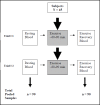Relationship between circulating cortisol and testosterone: influence of physical exercise
- PMID: 24431964
- PMCID: PMC3880087
Relationship between circulating cortisol and testosterone: influence of physical exercise
Abstract
Human research has shown the administration of cortisol into the circulation at rest will result in reduced blood testosterone levels. Many researchers have used these results to imply that physical exercise induced cortisol increases would perhaps result in subsequent reductions in circulating testosterone levels. Our purpose was to examine this concept and determine what, if any, relationship exists between circulating cortisol (C) and testosterone (T) in men (n = 45, 26.3 3.8 yr) at rest and after exercise. Blood samples were collect at rest (10 hour post-prandial; denoted as 'Resting'; n = 45) and again on the same day at 1.0 hr into recovery from intensive exercise (denoted as 'Exercise Recovery'; n = 45). Approximately 48-96 hr after this initial (Trial # 1) blood collection protocol the subjects replicated the exact procedures again and provided a second Resting and Exercise Recovery set of blood samples (Trial # 2). Blood samples from Trial # 1and Trial # 2 were pooled (Resting, n = 90; Exercise Recovery, n = 90). The blood samples were analyzed by radioimmunoassay for C, total T (TT), and free T (fT). Pearson correlation coefficients for the Resting samples ([TT vs. C] r < +0.01; [fT vs. C] r = +0.06) were not significant (p > 0.05). For the Exercise Recovery samples ([TT vs. C] r = -0.53; [fT vs. C] r = +0.21) correlation coefficients were significant (p < 0.05). The findings indicate that exercise does allow the development of a significant negative relationship between C and TT. Interestingly, a significant positive relationship developed between C and fT following exercise; possibly due to an adrenal cortex contribution of fT or disassociation of fT from sex hormone binding globulin. The detected in vivo relationships between C and T, however, were associative and not causal in nature and were small to moderate at best in strength. Key PointsPharmacologically increased levels of cortisol have a significant negative effect on circulating testosteroneAfter certain types of physical exercise a negative statistical associative relationship exist between cortisol and total testosterone.
Keywords: Glucocorticoids; androgens; exercise.
Figures



References
-
- Bambino T.H., Hsueh A.J. (1981) Direct inhibitory effect of glucocorticoids upon testicular lutenizing hormone receptor and steroidogenesis in vivo and in vitro. Endocrinology 108, 2142-2148 - PubMed
-
- Bonifazi M., Lupo C. (1996) Differential effects of exercise on sex-hormone-binding globulin and non-sex hormone-binding globulin-bound testosterone. European Journal of Applied Physiology 72, 425-429 - PubMed
-
- Castro W., Matt K.S. (1997) Neuroendocrine correlates of separation stress in the Siberian dwarf hamster (Phodopus sungorus). Physiological Behavior 61, 477-484 - PubMed
-
- Cohen J. (1988) Statistical power analysis for the behavioral sciences. 2nd edition New Jersey: Lawrence Erlbaum Publishing
LinkOut - more resources
Full Text Sources
